Abstract
Osteosarcoma (OS), the most common primary malignant bone tumor in children and adolescents, lacks an effective therapy. Stromal cell-derived factor (SDF-1) and its receptor, CXCR4, play multiple roles in migration, proliferation, and survival of different tumor cells. This study aimed to investigate whether the functional SDF-1/CXCR4 signaling mediates chemotaxis in F5M2 OS cells as well as the underlying mechanisms. Immunohistochemistry and immunofluorescence microscopy were used. RNA expression was detected by real-time quantitative polymerase chain reaction, and protein expression was examined by Western blotting. Migration assays were carried out in F5M2 cells. The results showed that the expression of CXCR4 and β-catenin mRNA and protein was significantly higher in OS tissues compared to the surrounding non-neoplastic tissues. SDF-1 promoted F5M2 cell migration by activating the AKT and Wnt/β-catenin signaling pathway, which was abrogated by preincubation with AMD3100 and LY294002. In conclusion, SDF-1/CXCR4 axis-promoted F5M2 cell migration was regulated by the Wnt/β-catenin signaling pathway.





Similar content being viewed by others
References
Link MP. Osteosarcoma in adolescents and young adults: new developments and controversies. Commentary on the use of presurgical chemotherapy. Cancer Treat Res. 1993;62:383–5.
Mirabello L, Troisi RJ, Savage SA. Osteosarcoma incidence and survival rates from 1973 to 2004: data from the surveillance, epidemiology, and end results program. Cancer. 2009;115:1531–43.
Ottaviani G, Jaffe N. The epidemiology of osteosarcoma. Cancer Treat Res. 2009;152:3–13.
Bacci G, Ferrari S, Bertoni F, Ruggieri P, Picci P, et al. Long-term outcome for patients with nonmetastatic osteosarcoma of the extremity treated at the istituto ortopedico rizzoli according to the istituto ortopedico rizzoli/osteosarcoma-2 protocol: an updated report. J Clin Oncol. 2000;18:4016–27.
Arndt CA, Rose PS, Folpe AL, Laack NN. Common musculoskeletal tumors of childhood and adolescence. Mayo Clin Proc. 2012;87:475–87.
Ferguson WS, Goorin AM. Current treatment of osteosarcoma. Cancer Invest. 2001;19:292–315.
Teicher BA, Fricker SP. CXCL12 (SDF-1)/CXCR4 pathway in cancer. Clin Cancer Res. 2010;16:2927–31.
Muller A, Homey B, Soto H, Ge N, Catron D, et al. Involvement of chemokine receptors in breast cancer metastasis. Nature. 2001;410:50–6.
Rossi D, Zlotnik A. The biology of chemokines and their receptors. Annu Rev Immunol. 2000;18:217–42.
Douglass S, Meeson AP, Overbeck-Zubrzycka D, Brain JG, Bennett MR, et al. Breast cancer metastasis: demonstration that FOXP3 regulates CXCR4 expression and the response to CXCL12. J Pathol. 2014;234:74–85.
Kim SY, Lee CH, Midura BV, Yeung C, Mendoza A, et al. Inhibition of the CXCR4/CXCL12 chemokine pathway reduces the development of murine pulmonary metastases. Clin Exp Metastasis. 2008;25:201–11.
Portella L, Vitale R, De Luca S, D’Alterio C, Ierano C, et al. Preclinical development of a novel class of CXCR4 antagonist impairing solid tumors growth and metastases. PLoS ONE. 2013;8:e74548.
Baumhoer D, Smida J, Zillmer S, Rosemann M, Atkinson MJ, et al. Strong expression of CXCL12 is associated with a favorable outcome in osteosarcoma. Mod Pathol. 2012;25:522–8.
Huang CY, Lee CY, Chen MY, Yang WH, Chen YH, et al. Stromal cell-derived factor-1/CXCR4 enhanced motility of human osteosarcoma cells involves MEK1/2, ERK and NF-kappaB-dependent pathways. J Cell Physiol. 2009;221:204–12.
McQueen P, Ghaffar S, Guo Y, Rubin EM, Zi X, Hoang BH. The Wnt signaling pathway: implications for therapy in osteosarcoma. Expert Rev Anticancer Ther. 2011;11:1223–32.
Zi X, Guo Y, Simoneau AR, Hope C, Xie J, et al. Expression of Frzb/secreted Frizzled-related protein 3, a secreted Wnt antagonist, in human androgen-independent prostate cancer PC-3 cells suppresses tumor growth and cellular invasiveness. Cancer Res. 2005;65:9762–70.
Mohinta S, Wu H, Chaurasia P, Watabe K. Wnt pathway and breast cancer. Front Biosci. 2007;12:4020–33.
Najdi R, Holcombe RF, Waterman ML. Wnt signaling and colon carcinogenesis: beyond APC. J Carcinog. 2011;10:5.
Ma Y, Ren Y, Han EQ, Li H, Chen D, et al. Inhibition of the Wnt-beta-catenin and Notch signaling pathways sensitizes osteosarcoma cells to chemotherapy. Biochem Biophys Res Commun. 2013;431:274–9.
Hu TH, Yao Y, Yu S, Han LL, Wang WJ, et al. SDF-1/CXCR4 promotes epithelial–mesenchymal transition and progression of colorectal cancer by activation of the Wnt/beta-catenin signaling pathway. Cancer Lett. 2014;354:417–26.
Holland JD, Gyorffy B, Vogel R, Eckert K, Valenti G, et al. Combined Wnt/beta-catenin, Met, and CXCL12/CXCR4 signals characterize basal breast cancer and predict disease outcome. Cell Rep. 2013;5:1214–27.
Chen X, Yang TT, Wang W, Sun HH, Ma BA, et al. Establishment and characterization of human osteosarcoma cell lines with different pulmonary metastatic potentials. Cytotechnology. 2009;61:37–44.
Osaki M, Takeshita F, Sugimoto Y, Kosaka N, Yamamoto Y, et al. MicroRNA-143 regulates human osteosarcoma metastasis by regulating matrix metalloprotease-13 expression. Mol Ther. 2011;19:1123–30.
Kong W, He L, Coppola M, Guo J, Esposito NN, et al. MicroRNA-155 regulates cell survival, growth, and chemosensitivity by targeting FOXO3a in breast cancer. J Biol Chem. 2010;285:17869–79.
Han K, Zhao T, Chen X, Bian N, Yang T, et al. microRNA-194 suppresses osteosarcoma cell proliferation and metastasis in vitro and in vivo by targeting CDH2 and IGF1R. Int J Oncol. 2014;45:1437–49.
Carloni V, Pinzani M, Giusti S, Romanelli RG, Parola M, et al. Tyrosine phosphorylation of focal adhesion kinase by PDGF is dependent on ras in human hepatic stellate cells. Hepatology. 2000;31:131–40.
Li X, Ma Q, Xu Q, Liu H, Lei J, et al. SDF-1/CXCR4 signaling induces pancreatic cancer cell invasion and epithelial–mesenchymal transition in vitro through non-canonical activation of Hedgehog pathway. Cancer Lett. 2012;322:169–76.
Guo M, Cai C, Zhao G, Qiu X, Zhao H, et al. Hypoxia promotes migration and induces CXCR4 expression via HIF-1alpha activation in human osteosarcoma. PLoS ONE. 2014;9:e90518.
Cai Y, Mohseny AB, Karperien M, Hogendoorn PC, Zhou G, Cleton-Jansen AM. Inactive Wnt/beta-catenin pathway in conventional high-grade osteosarcoma. J Pathol. 2010;220:24–33.
Clevers H, Nusse R. Wnt/beta-catenin signaling and disease. Cell. 2012;149:1192–205.
Shen X, Artinyan A, Jackson D, Thomas RM, Lowy AM, Kim J. Chemokine receptor CXCR4 enhances proliferation in pancreatic cancer cells through AKT and ERK dependent pathways. Pancreas. 2010;39:81–7.
Wang L, Li CL, Wang L, Yu WB, Yin HP, et al. Influence of CXCR4/SDF-1 axis on E-cadherin/beta-catenin complex expression in HT29 colon cancer cells. World J Gastroenterol. 2011;17:625–32.
Gentilini A, Rombouts K, Galastri S, Caligiuri A, Mingarelli E, et al. Role of the stromal-derived factor-1 (SDF-1)-CXCR4 axis in the interaction between hepatic stellate cells and cholangiocarcinoma. J Hepatol. 2012;57:813–20.
Azab AK, Runnels JM, Pitsillides C, Moreau AS, Azab F, et al. CXCR4 inhibitor AMD3100 disrupts the interaction of multiple myeloma cells with the bone marrow microenvironment and enhances their sensitivity to therapy. Blood. 2009;113:4341–51.
Acknowledgments
This study was supported by the National Natural Science Foundation of China (Nos. 81272441, 81201633, 81372297).
Conflict of interest
The authors declare that there is no conflict of interest in this study.
Author information
Authors and Affiliations
Corresponding authors
Additional information
Yao Lu, Bin Hu, and Guo-Feng Guan have contributed to this work equally.
Rights and permissions
About this article
Cite this article
Lu, Y., Hu, B., Guan, GF. et al. SDF-1/CXCR4 promotes F5M2 osteosarcoma cell migration by activating the Wnt/β-catenin signaling pathway. Med Oncol 32, 194 (2015). https://doi.org/10.1007/s12032-015-0576-0
Received:
Accepted:
Published:
DOI: https://doi.org/10.1007/s12032-015-0576-0




